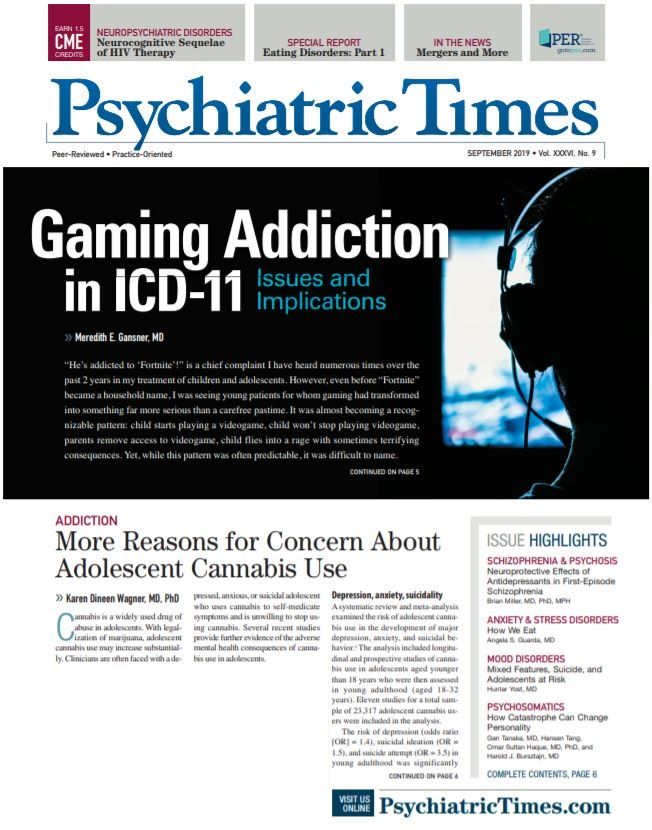Publication
Article
Psychiatric Times
Mergers and More Rock the Pharmaceutical Industry
Author(s):
From drug company mergers to government watchdogs, important trends are emerging.
©chagpg@stock.adobe.com

From drug company mergers to government watchdogs, important trends as the pharmaceutical industry balances the need for innovation with the need for financial support for that innovation are emerging this summer.
AbbVie announced the $63 billion acquisition of Allergan, which would make the new company a $48 billion enterprise.1 While AbbVie’s current top-selling drug is Humira (adalimumab), it has recently invested in neuroscience, investigating potential drugs for Parkinson disease, multiple sclerosis, and Alzheimer disease. Meanwhile, Allergan has concentrated on oncology, virology, and neuroscience products. Allergan’s current neuroscience lineup includes Vraylar (cariprazine), Viibryd (vilazodone), Saphris (asenapine), Fetzima (levomilnacipran), Namenda (memantine), and Namzaric (memantine and donepezil).
The merger could have a positive impact on the psychiatric drug pipeline, which has been largely ignored in the recent past. In a note to investors, Canaccord Genuity analyst Sumant Kulkarni shared, “We are encouraged by the focus that ABBV [AbbVie] is placing on AGN [Allergan]’s neurology/psychiatry assets.”1 He added that the neuroscience market drugs could get more competitive because of this merger, since the combined companies are expected to invest in migraine and schizophrenia/bipolar depression candidates.
“We believe this deal brings some attention back to the scarcity value of later-stage/filed neuro-related assets,” Kulkarni wrote. “While several major pharmas have deemphasized neuroscience, ABBV is one that has a presence in neuroscience, which will get even larger if the AGN acquisition closes.”1
Other recent mergers include Bristol-Myers Squibb and Celgene, Pfizer and Array BioPharma, Eli Lilly and Loxo Oncology, and Roche and Spark Therapeutics.2
Accusations against UK antidepressant suppliers
In the United Kingdom, four antidepressant suppliers found themselves in hot water with the Competition and Markets Authority (CMA) regarding anti-competitive conduct. The CMA accused King Pharmaceuticals and Auden Mckenzie of “sharing out” the antidepressant nortriptyline, with Auden Mckenzie only supplying 10-mg nortriptyline tablets while King only supplied the 25-mg tablets. The agency also accused King, Alissa, and Lexon of “exchanging commercially sensitive information, including information about prices, volumes and entry plans, to try to keep Nortriptyline prices high.”3
Evergreening bill introduced
On this side of the pond, legislators took aim at the pharmaceutical industry tactic known as “evergreening,” in which companies make minor changes to a popular drug and file for patents to extend their exclusivity and higher prices. Introduced by Representatives Hakeem Jeffries (D) from New York and Doug Collins from Georgia (R), the bipartisan Terminating the Extension of Rights Misappropriated (TERM) Act of 2019 places the burden of proof on the pharmaceutical companies to demonstrate “distinct inventions” to qualify for a new patent. “The bipartisan TERM Act will curb patent abuses in order to expedite the entrance of lower cost generic drugs to market,” explained Jeffries.4
Pharmaceutical companies are great innovators that create life-saving cures and treatments for families everywhere,” added Collins. “Unfortunately, some manufacturers simply file additional patents to delay generic drugs from coming to market. I co-sponsored the TERM Act to make it easier and fairer for generic pharmaceutical companies to challenge trivial patents, which ultimately means that patients get access to more drug options faster.4
Judge blocks direct-to-consumer rule
All this comes about as President Trump’s attempt to control drug prices in the US met failure. Through his health care initiatives, the Department of Health & Human Services (HHS) issued a rule in May that direct-to-consumer (DTC) advertisements must note the prices of drugs exceeding $35 per month if those drugs are covered by Medicare and Medicaid.5 The goals were to inform patients of costs and to put pressure on pharmaceutical companies to keep prices in check.
In presenting the rule in May, HHS Secretary Alex Azar (and former president of the Eli Lilly US division) said, “Patients have a right to know [the prices of medications], and if you’re ashamed of your drug prices, change your drug prices. It’s that simple.”5
Not surprisingly, the industry did not take the rule lightly. Eli Lilly, Merck, Amgen, and the Association of National Advertisers (ANA) filed a joint lawsuit alleging that the HHS rule was unconstitutional and infringed on their First Amendment rights to free speech.6 They also argued that the cost may change from patient to patient, as the out-of-pocket costs vary depending on insurance coverage and other programs; this, in turn, could mislead consumers. ANA and the companies argued that it was not in the purview of HHS to make the ruling. Ultimately, US District Judge Amit P. Mehta agreed with ANA and the pharmaceutical companies.
To be clear, the court does not question HHS’s motives in adopting the … disclosure rule,” explained Mehta in blocking the HHS rule. “Nor does it take any view on the wisdom of requiring drug companies to disclose prices. That policy very well could be an effective tool in halting the rising cost of prescription drugs. But no matter how vexing the problem of spiraling drug costs may be, HHS cannot do more than what Congress has authorized. The responsibility rests with Congress to act in the first instance.7
For their part, the pharmaceutical industry seemed pleased with the outcome. “We believe strongly in providing patients and their caregivers the meaningful information they need to make informed health care decisions. That is why we initiated this action,” a Merck spokesman said in a statement following the ruling.8
A Lilly spokeperson added, “We are committed to working with stakeholders across the health care system to find better solutions for the larger issue, namely, lowering out-of-pocket costs for Americans who still struggle to pay for their medicines.”8
Credit should be given to the Pharmaceutical Research and Manufacturers of America (PhRMA) for being proactive on DTC advertising and pricing. In October 2018, they enhanced their 2006 voluntary DTC principles, Guiding Principles on Direct-to-Consumer Advertisements About Prescription Medicines. The principle
states:
All DTC television advertising that identifies a medicine by name should include direction as to where patients can find information about the cost of the medicine, such as a company-developed website, including the list price and average, estimated, or typical patient out-of-pocket costs, or other context about the potential cost of the medicine.9
It is interesting to note that Eli Lilly was the first company to add pricing information. They currently list cost information for six of their branded pharmaceuticals.8
What’s next?
What’s next is anyone’s guess. Caitlin Oakley, HHS spokesperson, noted that the administration “will be working with the Department of Justice on next steps related to the litigation.”7 Meanwhile, Senate Finance Committee Chairman Chuck Grassley (R-Iowa) and Senator Dick Durbin (D-Ill) have introduced a bipartisan transparency bill that would require pharmaceutical companies to list prices of their prescription drugs in DTC advertisements.10 And the ANA’s Group Executive Vice President for Government Relations added, “ANA will continue to vigorously uphold the vital First Amendment rights of the advertising community.”11
References:
1. Philippidis A. AbbVie prepares for life after Humira with planned $63B Allergan acquisition. Genetic Engineering and Biotechnology News. 2019.
2. Herman B. With cash to burn, pharma deals are all the rage. Axios. 2019.
3. Smith A. 4 pharma companies accused of anti-competitive conduct. PharmaTimes Online. 2019.
4. Rep. Jeffries introduces bipartisan legislation to lower skyrocketing cost of prescription drugs. Press release. 2019.
5. Weixel N. Trump officials seek plan B on drug pricing rule. The Hill. 2019.
6. Heath A. Pharma companies file lawsuit against HHS price transparency rule. Patient Engagement Hit. 2019.
7. Mineiro M. Judge blocks Trump move on prescription drug prices. Courthouse News Service. 2019.
8. Bulik BS. Judge blocks Trump move on prescription drug prices. FiercePharma. 2019.
9. PhRMA members take new approach to DTC television advertising. PhRMA press release. 2019.
10. Durbin-Grassley amendment passes Senate to take on big pharma. Chuck Grassley press release. 2019.
11. ANA hails court ruling blocking HHS price disclosure rule. ANA press release. 2019.







